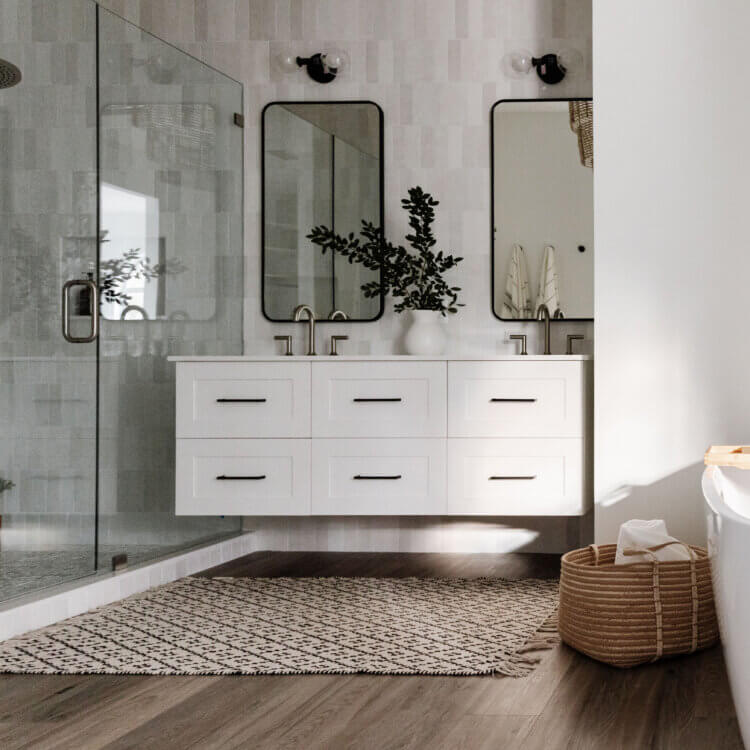In the realm of interior design, even the smallest details can make a significant impact. One such detail that often goes unnoticed but plays a crucial role in both aesthetics and functionality is the height of bathroom vanities. Modern bathroom vanities come in a range of heights, each serving a specific purpose and catering to different needs. In this comprehensive guide, we’ll delve into the world of modern bathroom vanities, exploring their varying heights, considerations for choosing the right height, and trends shaping contemporary bathroom designs.
Understanding Bathroom Vanities

Before we dive into the specifics of vanity heights, let’s first establish what exactly constitutes a bathroom vanity. A bathroom vanity is a combination of a sink and cabinets that not only provides storage space but also conceals plumbing lines. It serves as a central fixture in bathrooms, facilitating daily activities such as face-washing, teeth-brushing, and grooming.
Standard Height Range
The standard height range for modern bathroom vanities typically falls between 32 inches and 36 inches. This range is widely accepted and commonly used in residential and commercial settings alike.
A vanity height of 32 inches is considered on the lower end of the spectrum, while a height of 36 inches represents the higher end. However, the most common standard height for modern bathroom vanities is 34 inches, which has emerged as the universal average.
The rationale behind this standard height range is to provide users with a comfortable and ergonomic experience while using the vanity for daily activities such as face-washing, teeth-brushing, and grooming. A height of 34 inches strikes a balance between accessibility for individuals of varying heights and aesthetic appeal within the overall bathroom design.
It’s important to note that while the standard height range serves as a guideline, personal preferences and specific needs may dictate deviations from these measurements. Factors such as user height, design aesthetics, and practical considerations should all be taken into account when determining the optimal height for a bathroom vanity. Ultimately, the goal is to create a functional and visually pleasing space that enhances the overall bathroom experience.
Factors Influencing Vanity Height

Choosing the right height for a bathroom vanity involves considering several factors to ensure both comfort and functionality. Let’s explore some key considerations:
User Height
User height is a crucial factor to consider when determining the appropriate height for a modern bathroom vanity. The primary objective is to ensure that the vanity is comfortable and functional for individuals of varying heights who will be using it regularly.
Taller individuals may find lower vanities uncomfortable because they may need to bend over excessively during daily activities such as washing their face or brushing their teeth. This can lead to strain on the back and discomfort over time. As a result, taller users typically prefer vanities with heights closer to the upper end of the standard range, around 36 inches.
Conversely, shorter individuals may struggle with taller vanities, as they may have difficulty reaching the sink comfortably or accessing storage areas within the cabinets. For shorter users, vanities with heights closer to the lower end of the standard range, around 32 inches, may be more suitable.
Couples or households with individuals of varying heights may need to find a compromise when selecting a vanity height. In such cases, it’s often advisable to choose a height that accommodates the taller user comfortably, as it’s generally easier for shorter individuals to adapt to a slightly taller vanity. This approach helps to minimize strain on the back and ensures that the vanity is accessible to all members of the household.
Ergonomics and Comfort
- Posture and Body Mechanics: The height of the vanity should promote proper posture and body mechanics during common bathroom tasks such as washing the face, brushing teeth, and applying skincare products or makeup. A vanity that is too low may force users to hunch over, leading to strain on the neck, shoulders, and lower back. Conversely, a vanity that is too high may require users to reach or stretch uncomfortably, causing fatigue and discomfort over time.
- Ease of Use: An ergonomic vanity height ensures that the sink and countertop are easily accessible to users of varying heights. The ideal height allows users to comfortably lean forward and use the sink without bending or straining. Additionally, the placement of faucets, handles, and other fixtures should be considered to ensure easy reach and operation for users of all ages and abilities.
- Accessibility: For individuals with mobility limitations or disabilities, an ergonomic vanity height is essential for promoting independence and accessibility in the bathroom. Lower vanities may be more accessible for wheelchair users or individuals with mobility aids, allowing them to comfortably reach the sink and utilize the vanity space without assistance.
- Customization: In some cases, customizing the height of the vanity to suit specific user needs may be necessary for optimal comfort and functionality. Custom vanities can be tailored to accommodate users of varying heights, ensuring that everyone in the household can use the bathroom comfortably and safely.
Existing Infrastructure
- Plumbing Placement: The height of the vanity must align with the location of the plumbing fixtures, including the sink drain and water supply lines. If the plumbing lines are fixed at a certain height, the vanity must be installed at a corresponding height to ensure proper functionality and connectivity. Modifying the plumbing infrastructure to accommodate a different vanity height can be complex and costly, so it’s often more practical to work within the existing constraints.
- Clearance Requirements: The placement of the vanity within the bathroom space must adhere to clearance requirements set forth by building codes and regulations. These requirements dictate the minimum distance between the vanity and adjacent fixtures such as toilets, bathtubs, and shower enclosures. Existing infrastructure may influence the available clearance space and impact the positioning of the vanity within the room.
- Structural Considerations: Structural elements such as walls and floors may impose limitations on the height and placement of the vanity. Load-bearing walls, floor joists, and plumbing chases may dictate the allowable height range for the vanity and influence the feasibility of certain design options. Renovations or modifications to the existing structure may be necessary to accommodate desired changes in vanity height.
- Aesthetic Integration: The height of the vanity should complement the overall aesthetic of the bathroom space and integrate harmoniously with other design elements. Existing architectural features such as moldings, baseboards, and tile patterns may influence the desired height of the vanity and inform decisions regarding style, finish, and material selection.
Trends in Vanity Heights

As with any aspect of interior design, trends in vanity heights evolve over time, reflecting changing tastes and preferences. Here are some notable trends shaping modern bathroom designs:
Floating Vanities
Floating vanities, which are mounted to the wall and appear to “float” above the floor, have surged in popularity in recent years. These vanities offer a sleek and contemporary aesthetic, with heights typically set at 34 inches or 36 inches. While they add a touch of elegance to bathrooms, floating vanities may require special mounting brackets and additional wall support, contributing to higher installation costs.
Customization and Personalization
With the growing demand for personalized spaces, custom bathroom vanities have become increasingly popular. Homeowners are opting for bespoke designs tailored to their specific needs and preferences, including custom heights that accommodate their unique requirements.
Integration of Technology
Advancements in technology have also influenced vanity design, with integrated features such as adjustable heights gaining traction. Motorized vanities that can be raised or lowered at the touch of a button offer enhanced convenience and accessibility, catering to users of all ages and abilities.
Choosing the Right Vanity Height

Selecting the appropriate height for a modern bathroom vanity involves a blend of practical considerations and design preferences. Here are some tips to help you make an informed decision:
Measure Your Space
Before purchasing a new vanity, carefully measure the available space in your bathroom to ensure that the chosen height fits seamlessly within the room’s dimensions. Consider factors such as clearance requirements, door swings, and adjacent fixtures to determine the optimal size.
Consider User Preferences
Take into account the preferences and needs of the primary users when selecting vanity height. If multiple individuals will be using the same bathroom, aim for a height that accommodates the tallest user while remaining comfortable for others.
Test Ergonomics
If possible, test the ergonomics of different vanity heights by visiting showrooms or trying out similar setups in friends’ or family members’ bathrooms. Pay attention to factors such as countertop height, sink depth, and ease of use to identify the most suitable option.
Consult with Design Professionals
Seek guidance from experienced interior designers or bathroom remodeling experts to gain valuable insights into the latest trends and best practices. They can offer personalized recommendations based on your specific requirements and help you navigate the myriad options available in the market.
Conclusion
The height of modern bathroom vanities plays a significant role in both aesthetics and functionality. From standard heights to customized designs, there are various options to suit every preference and need. By considering factors such as user height, ergonomics, and design trends, homeowners can select the perfect vanity height to enhance their bathroom space. Whether opting for a sleek floating vanity or a custom-designed masterpiece, finding the ideal height ensures a harmonious blend of style and comfort in the modern bathroom.
